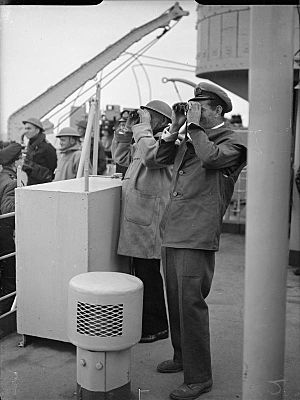Harold Campbell (courtier) facts for kids
Sir Harold George Campbell (born April 6, 1888 – died June 9, 1969) was an important British sailor and a special helper to the Royal Family. He worked for King George VI and later for Queen Elizabeth II.
Contents
A Brave Sailor in World War I
Harold Campbell was born in Kensington, England. He joined the Royal Navy and served during the First World War. He showed great bravery during a famous mission called the Zeebrugge Raid.
The Zeebrugge Raid
The Zeebrugge Raid was a daring attack in 1918. The goal was to block a German submarine base in Belgium. Campbell commanded a ship called the Daffodil. This ship was once a ferry boat from the River Mersey.
During the raid, a larger ship, the HMS Vindictive (1897), was trying to reach the mole. A mole is a long pier that protects a harbor. The Vindictive was struggling to get close enough. Enemy fire was very heavy. Campbell used the Daffodil to push the Vindictive's front end into the mole. This helped the larger ship complete its mission.
A historian later praised Campbell's skill. They said that only a very good sailor could have moved the ferry boat so perfectly. This was especially true during such a confusing and dangerous moment. For his brave actions, Campbell received the Distinguished Service Order. This is a special award for military bravery.
Serving the Royal Family
After his naval career, Campbell began working for the Royal Family. He became a Private Secretary to the Duke of York from 1933 to 1936. A Private Secretary helps with important papers and plans.
Working for the King
When the Duke of York became King George VI in 1936, Campbell continued to serve him. He was appointed as an equerry. An equerry is an officer who helps the King or Queen with their daily duties. He also became the Groom of the Robes to Queen Elizabeth. This role involved helping with royal ceremonies and clothing.
Campbell served King George VI until the King's death in 1952. He then continued to serve Queen Elizabeth II until 1954. From 1954 until his own death in 1969, he was an Extra equerry. This meant he still helped the Queen when needed.
Royal Honors
The King and Queen recognized Campbell's loyal service. He received several honors from the Royal Victorian Order. This order is given by the monarch for personal service. He was made a Commander (CVO) in 1935. He was later promoted to Knight Commander (KCVO) in 1943. Finally, he became a Knight Grand Cross (GCVO) in 1953. These honors showed how much his work was valued by the Royal Family.


